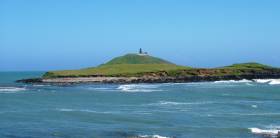Displaying items by tag: East Cork
Youghal’s New Pontoon Now Under Assembly
#Youghal - The components for Youghal’s new marina pontoon have arrived, and the amenity is currently being installed in the East Cork town.
Preparation for the new embarkation pontoon began last November with pile driving works in the harbour, as previously reported on Afloat.ie.
The pontoon marks the fruition of longstanding community efforts to build a marina for the town — and is hoped to “bring a welcome boost to our capability as a destination for marine tourism”, according to the Build a Marina in Youghal page on Facebook.
Ballycotton Island on the East Cork Coastline & Eloping by Semaphore
A few weeks ago I rounded Ballycotton Island on the East Cork coastline, sailing beneath the iconic, dramatic black lighthouse which towers 195 feet above sea level. It was erected in 1851, the construction led by the renowned engineer George Halpin who, as Inspector of Lighthouses, established 53 of them and modernised another 15.
As the wind died away our Sigma 33, SCRIBBLER, needed the reaching spinnaker hoisted to get across Ballycotton Bay to the finish line off the small harbour’s pier wall. It was the re-establishment of the annual race from the Royal Cork Yacht Club in Crosshaven to Ballycotton.
That distance is about a nautical mile and, relaxing afterwards over refreshment in the village, I heard the tales of how Lightkeepers on the island, in the days before modern communications, kept in touch with their wives living ashore…. by semaphore, the signalling system invented by Frenchman, Claude Chape, in 1792 as a “visual telegraph,” using crossbars with pivoting arms on top of towers. Napoleon used it to communicate strategy to his armies. The British Royal Navy developed naval flag semaphore which they used to defeat the French at the Battle of Trafalgar.
But it is unlikely that either Chape, Napoleon or the British, envisaged semaphore helping a Lightkeeper to elope with another Lightkeeper’s daughter…This story I narrated, subsequent to the race, on a documentary about Ballycotton Lighthouse and its Keepers produced by Community Radio Youghal Programme Director, Justin Maher, in which Ballycotton Historian, Derry Keogh, a guide with the community project, Ballycotton Lighthouse Tours, revealed another use for semaphore:
Listen to the PODCAST below.
• Tom MacSweeney presents THIS ISLAND NATION radio programme

























































